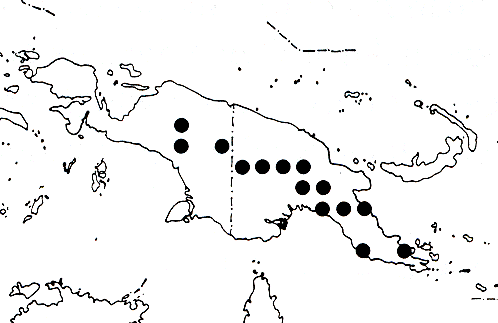
Distribution Map

Description (Barlow 1992)
Loranthus caudiciflora Lauterbach, Nova Guinea 8 (1910) 290. -Amyema caudiciflora (Lauterbach) Danser, Bull. Jard. Bot. Buitenzorg III, 10 (1929) 294. - Type: Versteeg 1473 (holo L; iso K, WRSL), New Guinea, southwest, Nordrivier near Geitenkamp, 10 vii.1907.
Loranthus gigantifolius Krause, Nova Guinea 14 (1923) 102.
- Amyema gigantifolia (Krause) Danser, Bull. Jard. Bot
Buitenzorg III, 10 (1929) 295. - Type: Lam 1875 (lecto
L, see below), New Guinea, ridge to the Doonnan Top, 1450 m, 2.xi.1920.
Amyema scandens subsp. crassifolia Barlow, Austral.
J. Bot. 22 (1974) 588. - Type: Hoogland & Schodde
7243 (holo CANB 84223; iso L 961,203-66), New Guinea, W Highlands,
Lagaip Valley, Kepilam, 2480 m, 30.vii.1960.
Glabrous. Stems usually robust, slightly enlarged at the
nodes, with papery bark when older; internodes terete, with scattered,
large, raised lenticels, 4-8(-13) cm long. Leaves ternate,
scattered-ternate, or quatemate; lamina usually ovate or obovate
or rarely lanceolate, (7-)12-21 cm long, (3-)6-10 cm wide, thick,
dull on both sides, cuneate or attenuate at the base and sessile
or with a short thick petiole up to 3 mm long, often recurved
at the margin, mostly rounded or rarely obtuse or broadly acute
at the apex; venation pennate, obscure except for the midrib distinct
and raised below. Inflorescences several at the nodes and
arising in groups from the lenticels of older stems; peduncle
(3-)10-15(-27) mm long, 1-2 mm thick; rays 4-6,5-9 mm long; flowers
all sessile in the triads; bracts triangular, c. 1.5 mm long,
rounded, forming a small spreading involucre below the triads.
Ovary barrel-shaped, 2.5-4 mm long; calyx limb truncate
or weakly toothed, 1-1.5 mm long, erect. Corolla in the
mature bud slender, 27-35 mm long, usually shortly rounded or
obtuse, 5- or 6-merous. Anther 2.5-4 mm long, about half
as long as the free part of the filament.
Stigma knob-like, 1.2-1.5 times wider than the style. Fruit
ovoid to nearly globular, 8-10 mm long, crowned by the calyx
limb and often by long persistent styles.
Amyema caudiciflora is endemic to New Guinea (fig. 8; 33
collections seen), in highlands at elevations from (500-)1250
to 2500 m. The species occurs in primary and secondary rain forest,
probably parasitic on a wide range of hosts including Calophyllum,
Castano psis, Macaranga, Nothofagus, and Opocunonia .
Amyema caudiciflora is a member of the Amyema scandens
species complex that can be identified in the Papuasian region
by the inflorescence of a 4- to 8-rayed umbel of triads with all
flowers closely sessile in an equidistant arrangement. Within
this group it can be identified by its leaves which are ternate,
scattered temate or quaternate, sessile or nearly so, thick, mostly
recurved at the margin and rounded at the apex. The corolla is
nearly always described as pink, rarely light or dark red.
The two species accepted here as A. caudiciflora
and A. plicatula essentially represent a change of
rank for two subspecies of A. scandens circumscribed by
Barlow (1974). For further discussion see under A. plicatula.
Amyema caudiciflora represents the entity fonnerly designated
as A. scandens subsp. crassifolia. Its cohesive
area is consistent with its recent differentiation as an adaptive
biotype in the emerging montane ecosystems of New Guinea.
The holotype of Loranthus gigantifolius, Lam 1875 (B),
is not extant An isotype in L has been seen and designated lectotype
of the name.
For further discussion, see under A. scandens.
Description (Barlow 1974)
As Amyema scandens subsp. crassifolia
Barlow, Austral. J. Bot. 22 (1974) 588
Illustrations
Photographs
Amyema caudiciflora
updated 18 January 2007